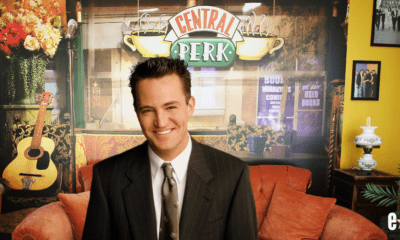Topics
The History of MGM Part 2: Into the Lion’s Den


I left off in my last article with the 1959 release of Ben-Hur, which was a huge commercial and critical hit for MGM and was basically the Titanic of its day. Unfortunately, though Ben-Hur‘s success carried MGM through the decade, the studio’s overreliance on big-budget films to save themselves would be their undoing when Cimarron (1960), King of Kings (1961), Four Horsemen of the Apocalypse (1961) and Mutiny on the Bounty (1962) all failed at the box office. The Oscar-nominated Western epic How the West Was Won (1962) was one of the studio’s few hits that decade, plus they did release a few highly regarded classics in the New Hollywood era like Doctor Zhivago (1965), The Dirty Dozen (1967), 2001: A Space Odyssey (1968) and Westworld (1973), but MGM was in bad financial shape ever since theater companies and film studios broke up and television began growing in popularity, and as with many old Hollywood studios in this period, corporate investors eventually got ahold of it.
In this case the investor was American businessman Kirk Kerkorian who was the father of the modern mega-resort and who helped shape Las Vegas in the sixties. In 1969, Kerkorian bought MGM Studios because he liked the glamour associated with the name and he subsequently founded two resorts, one that opened in Paradise, Nevada in 1973 called the MGM Grand Hotel and Casino (which later changed its name to Horseshoe Las Vegas in 2022) and one that opened in Las Vegas, Nevada in 1993 called the MGM Grand Las Vegas.


Kerkorian’s focus on his resort business only led to the film distribution part of the company becoming even less relevant, and in 1973 MGM Studios finally ceased distribution operations to United Artists in a ten-year distribution deal. Together with UA, MGM had a few successful films like dystopian sci-fi tale Logan’s Run (1976) and the critically acclaimed satire Network (1976), although the box office failure of UA’s Heaven’s Gate (1980) led to parent company Transamerica Corporation abandoning UA, so a year later MGM purchased UA and merged with the studio to become a distribution company called the MGM/UA Entertainment Company. The newly formed company distributed a combination of well-known hits and cult hits in the eighties, such as Rocky III (1982), Poltergeist (1982), The Secret of NIMH (1982), Pink Floyd the Wall (1982), WarGames (1983), Octopussy (1983), A Christmas Story (1983), Red Dawn (1984), A View to a Kill (1985), Moonstruck (1987), Willow (1988), A Fish Called Wanda (1988) and Rain Man (1988), which proved that MGM was still capable of releasing award-worthy movies.

That’s when Ted Turner came into the picture. I already covered Ted Turner in my series of articles about the history of Warner Bros. Animation, but just to briefly go over it again, Ted Turner is the American businessman who founded the cable television networks TBS, TNT and Cartoon Network and who in the eighties began purchasing the television rights to the film libraries of several Hollywood studios, most famously the films of Warner Bros. and MGM. Turner originally bought the entire MGM/UA studio from Kirk Kerkorian in 1986, but that deal left Turner with so much debt that he changed his mind and sold the studio back to Kerkorian while keeping the television rights to MGM’s pre-1986 film library, which left Turner with plenty of content for his TV networks. In fact TNT (Turner Network Television) launched in 1988 with the inaugural airing of Gone with the Wind, and Turner’s networks would regularly air classic MGM films ever since.

While Turner owned pre-1986 MGM, Kerkorian continued owning post-1986 MGM plus UA, but Kerkorian was more interested in exploiting MGM’s brand appeal for money than actually running a film studio, and this meant that many companies sought to buy MGM Studios from Kerkorian, including at various points 20th Century Fox owner Rupert Murdoch and, again, Ted Turner. But both those offers were rejected and for a long time MGM was limping along through the 1980s, 1990s and 2000s often partnering with other companies to stay alive, including when they formed a partnership with French film studio Pathé to form MGM-Pathé Communications, which had a largely unsuccessful run from 1990 to 1992 aside from the release of Ridley Scott’s Thelma & Louise (1991), but MGM mostly just hopped from potential buyer to potential buyer that decade, with even The Walt Disney Company and NBC owner General Electric showing interest in buying the studio (Time Warner and Sony are the two that came the closest to buying MGM, but MGM was such a volatile company and one that was run in such a messy way at this time that they could never really land a buyer in a smooth legal way that all parties felt was worth it).
Eventually in 1996, Kerkorian decided to repurchase MGM, and in order to strengthen the company MGM acquired the assets of Metromedia (the media company formed in the aftermath of defunct TV network DuMont) and as a result ended up owning Orion Pictures, the Samuel Goldwyn Company and low-budget film distributor Motion Picture Corporation of America (MPCA). MGM also got a boost from the success of Stargate SG-1 and the James Bond films around this time, as well as the success of films like Legally Blonde (2001), Barbershop (2002), Agent Cody Banks (2003), The Amityville Horror (2005), Clerks II (2006) and Hot Tub Time Machine (2010).


MGM would eventually halt courting buyers and remain independent with the intent to return to film distribution in 2006, teaming up with companies like Weinstein, New Line, Sony and Fox with the handling of their theatrical, television and home video releases. Which of course would lead to successful films like Casino Royale (2006) and Vicky Cristina Barcelona (2008). But none of this was enough to save MGM from filing for bankruptcy in 2010. This could have been the end of MGM, but apparently there is something about that roaring lion that still holds a lot of sway in Hollywood because later that year MGM re-emerged with the new CEO team of Gary Barber and Roger Birnbaum, formerly of Spyglass Entertainment.
The company was back in operation and still making films but it was still in weak shape even after its miraculous rebirth, mostly getting by, again, on partnerships with other companies like Annapurna Pictures and Canadian film company Bron Studios, which together with MGM released films like The Addams Family (2019), Candyman (2021), House of Gucci (2021), Licorice Pizza (2021) and the musical Cyrano (2022). But in 2021, tech company Amazon announced their intention to buy MGM, and the sheer size and wealth of Amazon as a corporation suggests that MGM may finally be on stable ground for the first time in decades.

The merging of Amazon and MGM led to the dissolution of Amazon Studios and the formation of Amazon MGM Studios, which has allowed MGM to return to being what they used to be: one of the major film distributors in Hollywood. And they are already having success with films like Saltburn (2023), American Fiction (2023) and Challengers (2024). Plus Amazon, seeming to recognize the value of the MGM name, is really putting the company front and center in their corporate identity, not just with the Amazon Studios rename but with the folding of United Artists, the releasing of MGM films on Prime Video and the name change of MGM’s premium cable network from Epix to MGM+.
Even though Disney pretty much took MGM’s place as the go-to Hollywood studio for big-budget family-friendly crowdpleasers and musicals, MGM did eventually claw its way back to prominence thanks to the mergers and partnerships of other studios. And this was partly because MGM did such a good job building a good reputation back when Louie B. Mayer was still running the place.
Take the legacy of MGM’s cartoon studio for example. I didn’t go into the studio’s animation history but characters like Barney Bear, the cat and mouse duo Tom and Jerry and hapless hound Droopy were major contributing factors to why that period is known as the Golden Age of Animation. Even Hanna-Barbera would not have existed without MGM thanks to the success Will Hanna and Joe Barbera had with Tom and Jerry at that studio for 17 years. Chuck Jones helped keep MGM cartoons (as well as Tom and Jerry) alive in the sixties and following the Turner acquisition, MGM Animation was briefly revived in 1993 for such projects as the feature film All Dogs Go to Heaven 2 (1996) and the TV series The Pink Panther (1993-96) but that studio went defunct in 2002, and after Warner Bros. bought Turner in 1996, many of the cartoon characters created at MGM have been utilized at WB in various animated projects (including a Tom and Jerry/Wizard of Oz crossover).

Another legacy of MGM that has managed to thrive is MGM Television. While MGM tried to capitalize on the success of television earlier with a series called MGM Parade that aired for a single season on ABC from 1955 to 1956 in an attempt to attract Walt Disney’s TV audience with their own family-friendly anthology series, MGM Television would be founded a year later with the original purpose of creating TV shows based on their films, such as The Thin Man, Dr. Kildare and Flipper. Of course they eventually strayed from that goal, which was obviously for the better. Some of the TV unit’s most successful shows were The Courtship of Eddie’s Father (1969-72), Medical Center (1969-76), CHiPs (1977-83) and in later years the ABC drama Thirtysomething (1987-91), Stargate SG-1 (1997-2007), Showtime’s Dead Like Me (2003-04), MTV’s Teen Wolf (2011-17), FX crime drama Fargo (2014-present) and Hulu’s dystopian drama The Handmaid’s Tale (2017-present).
One thing that’s for sure is that MGM has been in a tornado of chaos for years, but I always hoped they would get their feet back on the ground eventually. Partly because it would make me sad as a cinephile to see Leo the Lion disappear from my screen forever. But also because the more film studios we have, the more opportunities for great films to get released. And while the studio is still a shell of what it used to be, the roaring lion still gives me chills as if I’m about to watch something epic. I think that’s partly why it has been able to survive, at least as a brand.











